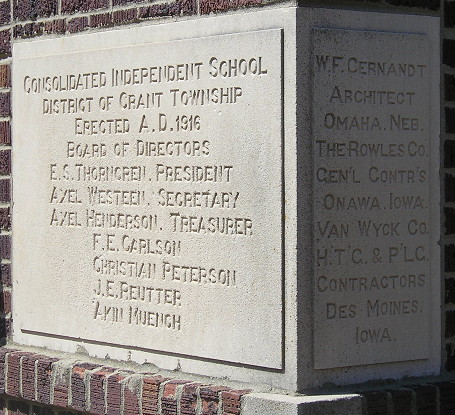
July 25, 2012: The cornerstone of the Boxholm school, last serving as Southeast Webster-Grand Junior High. The Boxholm school is not currently in use.
By the summer of 2013, residents of the Corwith-Wesley district knew their high school was a goner. Corwith-Wesley and LuVerne had voted in April to begin whole-grade sharing discussions with Algona. But when CW was asked how it could be a school district without students, the dissolution process began.
In 2014-15 the Des Moines Register embarked on its “Lost Schools” project, focusing on Corwith-Wesley’s dissolution and the first year of whole-grade sharing between Prairie Valley and Southeast Webster-Grand. Both of these cases dwarfed nearly everything that had come before.
In the September 2014 vote to dissolve Corwith-Wesley, 87.1% of the district was attached to LuVerne, and another 7.1% directly attached to Algona. (Algona Upper Des Moines, 9/4/14) The remainder, split off to West Hancock and Clarion-Goldfield-Dows, turned out to make a difference in the state record.
Algona, which had just finished digesting Titonka (and Burt a while before that), would now get CWL’s junior high and high school students. Algona High School now covers 550 square miles, from County Road A42 to the Kossuth/Humboldt county line and from Whittemore to southwestern Hancock County. It took the title of “largest area in Iowa for one high school” away from neighboring North Union, which had only had it for three years. However, a future consolidation with LuVerne, should one occur, would not result in Algona surpassing Western Dubuque as “largest school district in the state” because of the fraction of CW that went elsewhere.
Prairie Valley and Southeast Webster-Grand, as Southeast Valley, spreads across the southern half of Webster County, west to Rinard, and south to Fraser. It’s a hairbreadth away from being 500 square miles (498) and brings together a dozen towns.
The 2013 sharing arrangement for North Fayette Valley, at 355 square miles in northeast Iowa, was dwarfed that same summer in the opposite corner by Corning and Villisca combining to form 420-square-mile Southwest Valley. The following year Mount Ayr, which had made it into the 350 club by gaining land from Grand Valley’s dissolution, would enter the 400 club the same way, gaining land on its western edge through a crazy-quilt carve-up of Clearfield. The year after that, Northeast Hamilton gave up its high school, and Webster City, through that arrangement and a longtime one with Stratford, crossed the 400 barrier too.
If you threw the three new “Valley”s together — Southeast Valley, Southwest Valley, and North Fayette Valley, six existing districts, three high schools — you would have 1,273 square miles and a K-12 certified enrollment of around 3,000. In comparison, West Des Moines Valley High School has 2,200 students in three grades in 37 square miles.
To be concluded…
